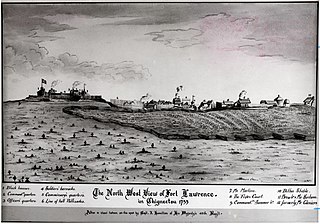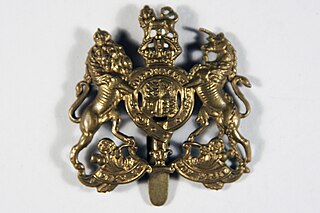Related Research Articles

RAF Henlow is a Royal Air Force station in Bedfordshire, England, equidistant from Bedford, Luton and Stevenage. It houses the RAF Centre of Aviation Medicine, the Joint Arms Control Implementation Group (JACIG), elements of Defence Equipment and Support, and the Signals Museum. It formerly hosted light aircraft flying and 616 Volunteer Gliding Squadron. The Ministry of Defence announced on 6 September 2016 that the base is set to be closed following a consultation.

The Intelligence Corps is a corps of the British Army. It is responsible for gathering, analysing and disseminating military intelligence and also for counter-intelligence and security. The Director of the Intelligence Corps is a brigadier.

Barracks are usually a group of long buildings built to house military personnel or laborers. The English word comes via French from an old Spanish word "barraca" (hut), originally referring to temporary shelters or huts for various people and animals, but today barracks are usually permanent buildings for military accommodation. The word may apply to separate housing blocks or to complete complexes, and the plural form often refers to a single structure and may be singular in construction.

New Fort York, later the Stanley Barracks, is a former British and Canadian military base in Toronto, Ontario, Canada, located on the Lake Ontario shoreline. It was built in 1840–1841 to replace Toronto's original Fort York at the mouth of Garrison Creek as the primary military base for the settlement. Unlike the older fort, many of the new fort buildings were made with limestone instead of wood. A protective wall was planned for the new fort but was never built. The fort was used by the British army until 1870, and the Canadian military subsequently used the fort to train troops for the Second Boer War, World War I and World War II. It also trained one of the first regiments of the North-West Mounted Police. The Canadian military stopped using it after World War II and the fort was demolished in the 1950s. Only the Officers' Quarters building remains on the site.

Fort Pitt is a Napoleonic era fort on the high ground of the boundary between Chatham and Rochester, Kent.
A military prison is a prison operated by a military. Military prisons are used variously to house prisoners of war, unlawful combatants, those whose freedom is deemed a national security risk by the military or national authorities, and members of the military found guilty of a serious crime. Thus, military prisons are of two types: penal, for punishing and attempting to reform members of the military who have committed an offense, and confinement-oriented, where captured enemy combatants are confined for military reasons until hostilities cease.

Fort Lawrence was a British fort built during Father Le Loutre's War and located on the Isthmus of Chignecto.

Stalag XX-A was a German World War II prisoner-of-war camp located in Toruń in German-occupied Poland. It was not a single camp and contained as many as 20,000 men at its peak. The main camp was located in seven forts of the 19th-century Toruń Fortress, located in the southern part of the city.

The siege of Fort St. Jean was conducted by American Brigadier General Richard Montgomery on the town and fort of Saint-Jean in the British province of Quebec during the American Revolutionary War. The siege lasted from September 17 to November 3, 1775.
Canadian Forces Base Calgary, also CFB Calgary, was a Canadian Forces Base located in Calgary, Alberta.

Larkhill is a garrison town in the civil parish of Durrington, Wiltshire, England. It lies about 1+3⁄4 miles (2.8 km) west of the centre of Durrington village and 1+1⁄2 mi (2.4 km) north of the prehistoric monument of Stonehenge. It is about 10 mi (16 km) north of Salisbury.

The Curragh Camp is an army base and military college in The Curragh, County Kildare, Ireland. It is the main training centre for the Irish Defence Forces and is home to 2,000 military personnel.

The Bermuda Volunteer Rifle Corps (BVRC) was created in 1894 as an all-white, racially segregated reserve for the Regular Army infantry component of the Bermuda Garrison. Renamed the Bermuda Rifles in 1951, it was amalgamated into the Bermuda Regiment in 1965.

5th Canadian Division Support Base Detachment Aldershot is a training facility for 5th Canadian Division of the Canadian Army. It is located in Kings County, Nova Scotia.

The siege of Port Royal, also known as the Conquest of Acadia, was a military siege conducted by British regular and provincial forces under the command of Francis Nicholson against a French Acadian garrison and the Wabanaki Confederacy under the command of Daniel d'Auger de Subercase, at the Acadian capital, Port Royal. The successful British siege marked the beginning of permanent British control over the peninsular portion of Acadia, which they renamed Nova Scotia, and it was the first time the British took and held a French colonial possession. After the French surrender, the British occupied the fort in the capital with all the pomp and ceremony of having captured one of the great fortresses of Europe, and renamed it Annapolis Royal.

The Bermuda Garrison was the military establishment maintained on the British Overseas Territory and Imperial fortress of Bermuda by the regular British Army and its local militia and voluntary reserves from 1701 to 1957. The garrison evolved from an independent company, to a company of Royal Garrison Battalion during the American War of Independence, and a steadily growing and diversifying force of artillery and infantry with various supporting corps from the French Revolution onwards. During the American War of Independence, the garrison in Bermuda fell under the military Commander-in-Chief of America. Subsequently, it was part of the Nova Scotia Command until 1868, and was an independent Bermuda Command from then 'til its closure in 1957.

The Bermuda Flying School operated on Darrell's Island from 1940 to 1942. It trained Bermudian volunteers as pilots for the Royal Air Force and the Fleet Air Arm.

The Bermuda Militia Infantry was raised in 1939 as a part-time reserve of the British Army's Bermuda Garrison.

Imperial fortress was the designation given in the British Empire to four colonies that were located in strategic positions from each of which Royal Navy squadrons could control the surrounding regions and, between them, much of the planet.
References
- British Parliamentary Hansards, 6 July 1943
- Canadian National Archives file, 666 (AOP)(RCAF) Squadron, War Diary